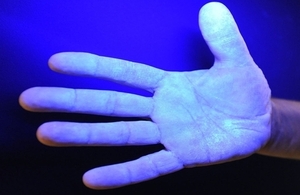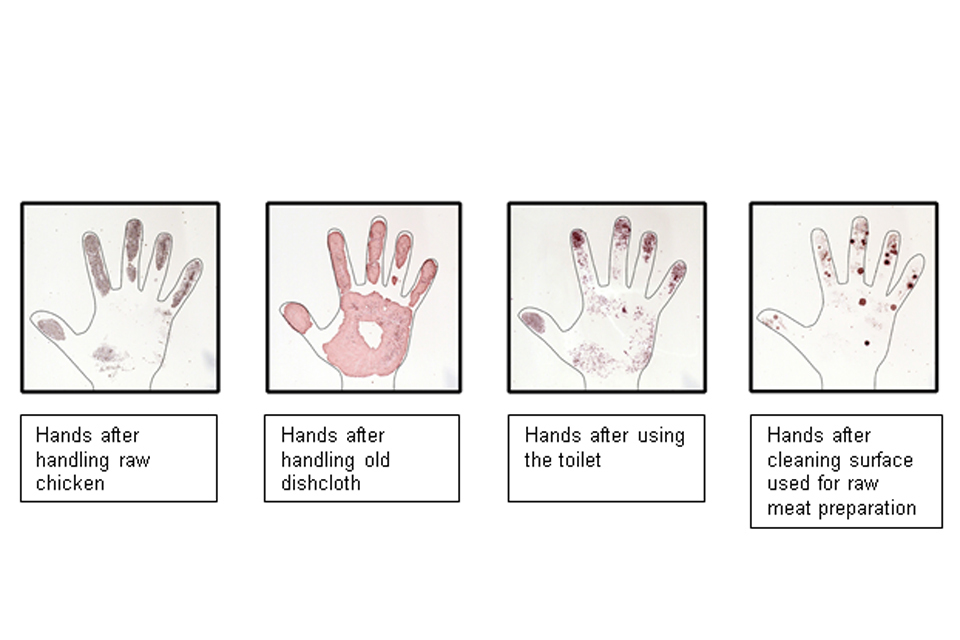The invisible bugs that lurk on your hands
Clean your hands day – PHE urges you to do your bit to help prevent the spread of harmful bugs by washing your hands using soap and water.

Bacteria highlighted on a hand
Public Health England (PHE) is supporting the World Health Organization’s (WHO) Clean your Hands campaign today (5 May 2014) by making that which is invisible, visible.
Our hands touch hundreds, possibly thousands of surfaces each day and hands play a key role in spreading bacteria and viruses, some of which may be harmful to our health.
They cause illness by what in scientific terms this is called the ‘faecal-oral’ route of transmission. This is where we touch surfaces and then put our hands, and the bugs - including ones that are found in human faeces - into our mouths. Bacteria from faeces are spread around when people don’t wash their hands after using the toilet, changing nappies, handling cat litter and similar activities.
This striking selection of photos is from pressing real hands onto a growth medium that only allow germs of potential faecal origin to grow. This was done after touching everyday objects and contaminated foods or after using the toilet. The coloured areas show bacterial colonies grown from contamination on the hands.

Bacterial colonoies grown from contamination on the hands
Peter Hoffman, an expert in infection control at PHE and the owner of the hands in the pictures, said:
People may not be aware of how many germs they get on their hands after doing a range of general everyday tasks so this series of photos really helps to highlight this. Just as contamination was passed from my hands to the growth surfaces in the pictures, so it could be passed from your hands to your mouth, the food you handle or any other route of infection. Handwashing is integral to breaking the cycle of transmission of harmful bugs whether that is in a hospital or in our own homes and everyone needs to adopt this very good habit.
Ingestion of these bacteria and viruses can cause a range of gastrointestinal and respiratory illnesses including ‘E.coli’ O157, norovirus, colds and flu. It is also a way in which highly antibiotic-resistant bacteria can be spread around. These are increasingly being recognised as a major threat to public health.
This next series of pictures show how the bacteria and viruses are removed with handwashing. It does not sterilise the hands but when done properly it greatly reduces contamination – that is why there are still some bacteria on the hands as seen in the photos. The more germs there are, the greater the chance they will cause an infection so handwashing is a method of reducing potential harm.

How the bacteria and viruses are removed with handwashing
Dr Paul Cosford, Director of Health Protection and Medical Director at PHE, said:
It is quite shocking to see just how many bacteria we get onto our hands from doing everyday tasks. If we don’t wash our hands properly then just one bacterium can grow into hundreds and thousands in a relatively short space of time. These are then spread around our environment and onto other people and so on. This is why it is so important that we wash our hands thoroughly particularly before preparing food, after handling raw meat and after going to the toilet.
Notes to editors
- e-Bug is a Europe-wide antibiotic and hygiene teaching resource led by PHE. Its guide to correct handwashing can be found from to the e-bug website
- Read the WHO campaign
- Download copies of the images: and
- Public Health England’s mission is to protect and improve the nation’s health and to address inequalities through working with national and local government, the NHS, industry and the voluntary and community sector. PHE is an operationally autonomous executive agency of the Department of Health.
www.gov.uk/phe Follow us on Twitter @PHE_uk
UKHSA press office: National Infection Service
UKHSA press office, infectious diseases
61 Colindale Avenue
London
NW9 5EQ